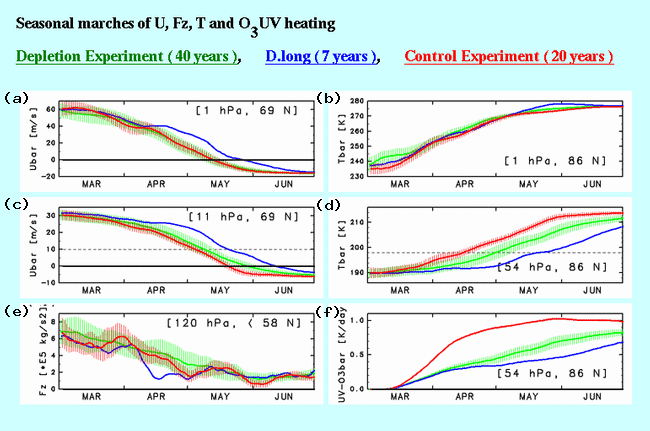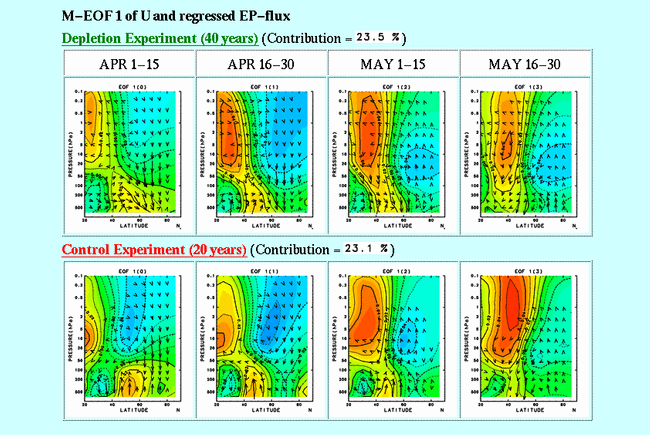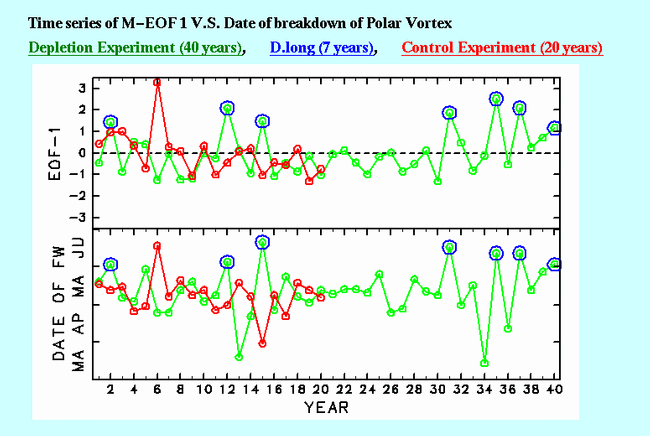Interannual variations of the general circulation and polar stratospheric
ozone losses in a general circulation model
Toshihiko Hirooka, Shingo Watanabe and Saburo Miyahara
Department of Earth and Planetary Sciences, Kyushu University,
Fukuoka 812-8581, Japan
hirook@geo.kyushu-u.ac.jp Tel:+81-92-642-2681 Fax:+81-92-642-2685
FIGURES
Abstract
Interannual variations of the general circulation and polar stratospheric
ozone losses are investigated by using a general circulation model
(GCM) developed at Kyushu University. The GCM includes simplified
ozone photochemistry interactively coupled with radiation and
dynamics in the GCM. Polar ozone depletion is brought about in
the GCM by a parameterized ozone loss term. We performed an 'ozone
depletion experiment' over successive 40 years with stratospheric
ozone losses formed over the Arctic and Antarctic polar regions,
along with a 'control experiment' which is a simulation without
the ozone loss term. Results of the ozone depletion experiment
show large interannual variations of the general circulation and
polar ozone losses especially in the Northern Hemisphere winter
and spring. It is found that the interannual variations are caused
not only by dynamical conditions in the stratosphere, e.g., strength
of the polar vortex and planetary wave activities, but also by
interaction mechanisms between dynamical and ozone fields; the
resultant interannual variability of the general circulation in
the stratosphere becomes larger than that in the control experiment.
Moreover, influences of the stratospheric ozone losses could extend
to the troposphere; overall three-dimensional patterns of the
interannual variations in dynamical fields seem to coincide well
with those of the Arctic Oscillation.
Introduction
Recently, large ozone depletion has been observed during early
spring over the Arctic. In particular, the ozone depletion during
spring 1997 exhibits many similarities to the Antarctic ozone
hole from the viewpoint of the ozone distribution as well as the
stratospheric general circulation. Radiative and dynamical impacts
of Antarctic ozone losses on the general circulation have been
investigated by several authors [e.g., Mahlman et al., 1994].
Our recent study using an interactive ozone chemistry general
circulation model (GCM) showed that Arctic ozone depletion also
led to decreased solar ultraviolet (UV) heating and lower temperatures,
resulting in a colder and stronger polar vortex, and brought about
strengthening and continuation of ozone depletion itself [Hirooka
et al., 1999a, b]. Interannual variability of ozone depletion
was, however, much larger in the Arctic than in the Antarctic,
because of larger variability of dynamical conditions, e.g., strength
of the polar vortex and planetary wave activities. The main purpose
of this study is to investigate relationship between interannual
variation of ozone depletion and that of the general circulation,
especially in the Northern Hemisphere winter-to-spring period.
Model and experiments
The GCM used in this study is a global spectral model developed
at our laboratory, with triangle truncation at wavenumber 21 in
the horizontal direction and 37 vertical layers extending from
the surface to about 83 km. The GCM includes realistic topography
and has a full set of physical processes, such as the boundary
layer, hydrology, dry and moist convection, and radiative processes.
Reyleigh friction and gravity wave drag parameterization are introduced
for the zonal momentum equation to represent the drag force due
to unresolved motions. The ozone mixing ratio is calculated for
the region up to about 55 km on the basis of a parameterized Chapman
cycle proposed by Hartmann [1978], in which the catalytic destruction
of ozone due to HOx and NOx is parameterized through the tuning
of reaction coefficients, whereas the ratio above that level is
prescribed by climatological values. The ozone destruction near
the surface is expressed by introducing a suitable deposition
velocity around 1 km altitude. Hence, the ozone field is coupled
interactively with the radiative and dynamical fields in the GCM.
For details, see Miyahara et al. [1995].
In order to simulate the ozone depletion, a parameterized loss
term is added in the continuity equation for the ozone mixing
ratio. The loss term is switched on for the region between 120
and 16 hPa, when three conditions are met, i.e., a noontime zenith
angle less than 85o, a temperature lower than 198 K, and a latitude
higher than 54o. We performed here an 'ozone depletion experiment'
including the loss term over successive 40 years, along with a
'control experiment' without the loss term over successive 20
years.
Results
Seasonal marches and their interannual variations
Figure 1 shows seasonal marches of zonal mean dynamical fields
and ozone UV heating at several high latitudes in the Northern
Hemisphere and levels. In each panel, green curve denotes the
average for the ozone depletion experiment, while red curve denotes
that for the control experiment. Vertical bars show standard deviations
for each calendars day. It is found that zonal mean zonal winds
and temperatures at 1 hPa for the both experiments show similar
seasonal marches, whereas in the lower stratosphere they are largely
different each other, especially for the temperature field. In
the ozone depletion experiment, the temperature at 86o N and 54
hPa are kept cold well below the threshold value of the ozone
loss term, 198 K, until the end of April, which is delayed by
about 2 weeks comparing to the control experiment. This is connected
with decreased ozone UV heating due to the Arctic ozone depletion.
For a period from the beginning of the sunlit period (mid-March
at 86o N) to the end of April, ozone UV heating in the ozone depletion
experiment is smaller than that in the control experiment by a
factor of 2. This is due mainly to the fact that the Arctic ozone
losses occur almost every spring in the ozone depletion experiment.

Figure 1. (a) Time series of the simulated zonal mean zonal wind at 69o
N and 1 hPa. Green, blue and red lines denote averages for "ozone
depletion experiment", "D.long years" (see the text) and "control
experiment", respectively. Vertical bars for the green and red
curves show standard deviations. (b) Same as (a) except for the
zonal mean temperature at 86o N and 11 hPa. (c) Same as (a) except
for the zonal mean zonal wind at 69o N and 11 hPa. Broken line
indicates 10 ms-1. (d) Same as (a) except for the zonal mean temperature
at 86o N and 54 hPa. Broken line indicates 198K. (e) Same as (a)
except for the vertical component of E-P flux averaged over north
of 58o N at 120 hPa. (f) Same as (a) except for the zonal mean
ozone UV heating at 86o N and 54 hPa.
It is also noted that the interannual variation, expressed by
the vertical bars, in the ozone depletion experiment is relatively
large throughout the period, which is closely connected with the
Arctic ozone depletion. Figure 2 shows the interannual variations
of the date of polar vortex breakdown at 11 hPa, which is defined
by the date when zonal mean zonal wind becomes smaller than 10
ms-1. Green circles show the breakdown date in the ozone depletion
experiment, and red ones show those in the control experiment.
The occurrence of final warmings in the ozone depletion experiment
widely distributes for the period from mid-March to late June.
As a result, in seven years denoted by blue circles, i.e. 2, 12,
15, 31, 35, 37, 40th years, the strong polar night jet and the
Arctic ozone depletion continue harmonically until June. We call
these seven years as 'D.long years' hereafter.

Figure 2. Interannual variation of date of breakdown of the polar vortex
at 11 hPa. Green, blue and red circles denote the ozone depletion
experiment, the D.long years (later than beginning of June) and
the control experiment, respectively.
The blue curve in Fig. 1 shows the average of each field in the
D.long years. Seasonal marches of the polar night jet, the polar
temperature and the ozone UV heating in the lower stratosphere
depart from each other from the latter half of April. In that
period, the vertical component of Eliassen-Palm (E-P) flux in
the lower stratosphere is smaller than other time series. Both
the easterly acceleration due to E-P flux divergence in the upper
stratosphere and the adiabatic heating related to descending motion
are small in high latitudes in the stratosphere (not shown). After
the period, final warmings occur in late May in the upper stratosphere,
but relatively strong westerlies, low temperature and small ozone
UV heating are maintained beyond the end of June in the lower
stratosphere. Moreover, the strong polar night jet and the low
temperature extend downward to the upper troposphere (not shown).
It is also found that decrease of UV heating due to the ozone
depletion in the polar lower stratosphere is a primary cause of
the thermal structure, which leads to keeping the polar night
jet strong until late spring. Similar to our former results [Hirooka
et al., 1999a, b], this causes strengthening and continuation
of the ozone depletion itself, through chemical destruction within
the polar vortex and interfering dynamical transport of ozone-rich
air from low latitudes. Hence, it is considered that the dynamically
calm period in late April is a precursor for these positive feedback
processes well shown in this experiment.
Relationships to the Arctic Oscillation
In order to investigate stratosphere-troposphere coupled interannual
variation in the springtime seasonal march, a multiple empirical
orthogonal function (M-EOF) analysis for the zonal mean zonal
wind is conducted for each experiment. The EOF analysis is performed
by combining multiple periods of data in a vector xi as
xi = ( ui(n), ui(n+1), ui(n+2), ui(n+3)),
where ui(n) is the anomalous period-mean zonal mean zonal wind
at each height and latitude for the nth period of the ith year.
The EOFs are then defined as the eigenvectors of the correlation
matrix calculated from xi. The data in the north of 20o N and
from 850 hPa to 0.1 hPa are used here. The EOFs are calculated
for consecutive data of four period chosen as below; 1:APR 1-15,
2:APR 16-30, 3:MAY 1-15,4:MAY 16-30. It is noted that the calculation
is conducted over 40 years data for the ozone depletion experiment,
while done over 20 years data for the control experiment.
Figure 3 shows the first mode of the M-EOF (EOF1) obtained from
above analysis, which accounts for 23.5% of variance. From green
to blue colors show westerly anomalies, while yellow to red colors
show easterly anomalies. Arrows show E-P flux vectors regressed
with a time series of the EOF1, which are scaled for better visualization
(the scaling factor is differed across 120 hPa). In the ozone
depletion experiment (upper panels), a meridional dipole pattern
of the zonal wind, which corresponds to the structure consisting
of strong polar night jet in high latitudes and weak westerlies
in subtropics, becomes strong and moves poleward and downward
from the upper stratosphere to the troposphere with time, to form
a barotropic structure similar to the so-called Arctic Oscillation
[Thompson and Wallace, 1998]. On the other hand, in the troposphere,
a reversed meridional dipole pattern comparing to the stratospheric
one is found in the fist period; as the stratospheric dipole pattern
moves downward, the polarity of the dipole in the troposphere
is changed. In other words, a phase shift of the meridional structure
occurs in relation to the stratospheric final warming.
Concerning E-P flux vectors corresponding to this mode, we can
see that they direct toward two centers of easterly wind anomalies
in the stratosphere and troposphere. In high latitudes, E-P flux
vectors direct downward in April, while they reverse to the upward
direction in May. This implies that in years when the polar night
jet is kept strong until late spring, planetary wave activity
in April is weak throughout the troposphere and the stratosphere,
while in May it becomes strong. On the other hand, in the troposphere,
poleward and downward vectors of the E-P flux converge in high
latitudes to cause westerly acceleration in April, then meridional
divergence and convergence formed by the poleward directed E-P
flux moves easterly wind anomaly toward the subtropics until late
May. As a result, the strong polar night jet extends from the
lower stratosphere to the troposphere in late spring. Note that
the zonal wavenumber 1 component is dominant in the vertical component
of the E-P flux, whereas the zonal wavenumber 2 component is dominant
for the meridional component in the troposphere, throughout the
analysis period.

Figure 3. The M-EOF first mode for the zonal mean zonal wind, and regressed
E-P flux. E-P flux vectors are scaled for better visualization
by changing scaling factors across 120 hPa. Colors from green
to blue represent westerly anomalies, from yellow to red show
easterly anomalies. Horizontal axis shows latitude from 20o N
to the north pole (from left to right). Vertical axis shows pressure
from 850 hPa to 0.1 hPa.
On the other hand, EOF1 of the control experiment shows no systematic
coupling of the stratosphere and the troposphere (lower panels
in Fig.3). In this case the EOF1 accounts for 23.1% of variance.
Although meridional dipole anomaly of the zonal wind moves poleward
and downward in the stratosphere, it does not reach as deep as
troposphere and becomes weak in late May. In the troposphere,
meridional tripole pattern is seen throughout the period, and
corresponding E-P flux vectors dominated by the zonal wavenumber
3 component cannot bring about a wind anomaly reverse. Hence in
the ozone depletion experiment, the interannual variation of the
polar night jet, which is enlarged by the positive feedback mechanism
of the ozone depletion, extends to the troposphere to form the
stratosphere-troposphere coupling, i.e. the Arctic Oscillation.
At the end of this section, it is interesting to see the time
series of the EOF1 principal component. Figure 4 shows the time
series of EOF1 along with dates of the breakdown of the polar
vortex at 11 hPa, shown in Fig. 2. The time series of EOF1 is
well correlated with dates of final warmings. It is found that
extreme values which exceed a standard deviation of the principal
component hardly appear in successive years, except for the 8th
and 9th years in the ozone depletion experiment. In addition,
these time series seem to have neither apparent periodicity nor
trend, though no D.long years appeared for the 20-30th year period.
Similar periods are considered to happen irregularly, because
surface conditions of the GCM, such as SST, are fixed to climatology,
and therefore there is no external memory or decadal forcing.

Figure 4. Upper: Time series of the standardized principal component of
the EOF1. Green, blue and red circles denote those of the ozone
depletion experiment, the D.long years (see the text) and the
control experiment, respectively. Lower: Same as in Figure 2.
Concluding remarks
In the present study, it was shown that the resultant interannual
variability of the general circulation in the stratosphere was
larger than that in the control experiment, which is due mainly
to the positive feedback mechanism of the Arctic ozone depletion.
Moreover, influences of the stratospheric ozone losses extend
to the general circulation in the troposphere. Concomitantly,
the stratosphere-troposphere coupled interannual variation, which
is extracted by the multiple EOF analysis for the springtime zonal
mean zonal wind, shows a more systematic character than that in
the control experiment.
Acknowledgments.
This work was supported by a Grant-in-Aid for the Cooperative
Research with Center for Climate System Research, University of
Tokyo, and by a Grant-in-Aid for Scientific Research from the
Ministry of Education, Science, Culture and Sports, Japan. The
GFD-DENNOU Library was used for drawing the figures.
References
Hartmann, D. L., A note concerning the effects of varying extinction
on radiative-photochemical relaxation, J. Atmos. Sci., 35, 1125,
1978.
Hirooka, T., M. Yoshikawa, S. Miyahara, and T. Kayahara, Radiative
and dynamical impacts of Arctic and Antarctic ozone holes: General
circulation model experiments, Adv. Space Res., 24, 1637-1640,
1999a.
Hirooka, T., T. Nishiyoshi, S. Watanabe, and S. Miyahara, Influences
of Arctic ozone hole on the stratospheric general circulation,
Polar Meteorol. Glaciol., 13, 1-10, 1999b.
Mahlman, J. D., J. P. Pinto, and L. J. Umscheid, Transport, radiative
and dynamical effects of the Antarctic ozone hole: A GFDL "SKYHI"
model experiment, J. Atmos. Sci., 51, 489, 1994.
Miyahara, S., Y. Miyoshi, T. Kayahara, Y. Yoshida, M. Ooishi,
and T. Hirooka, Development of a Middle Atmosphere General Circulation
Model at Kyushu University, Climate System Dynamics and Modeling,
Center for Climate System Research, University of Tokyo, pp. 75-103,
1995.
Thompson, D. W. J., and J. M. Wallace, The Arctic Oscillation
signature in the wintertime geopotential height and temperature
fields, Geophys. Res. Lett., 25, 1297-1300, 1998.
Back to



